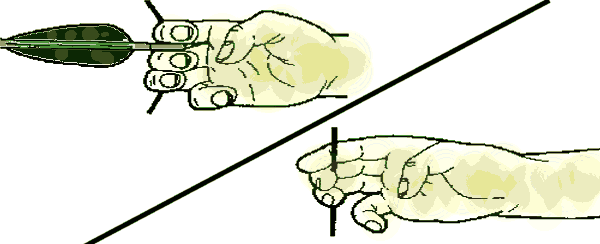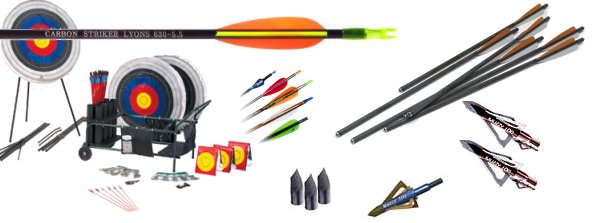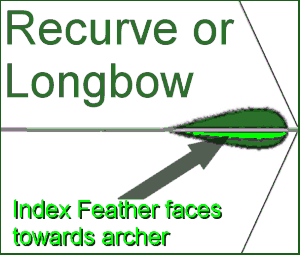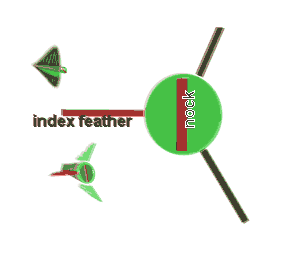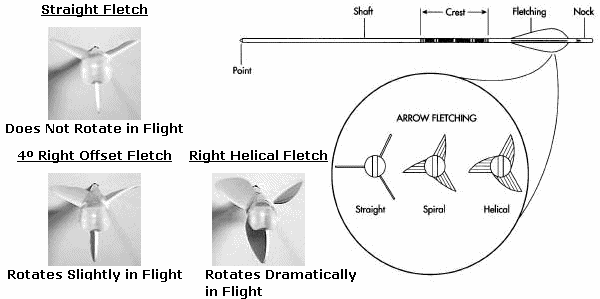Arrows and Archery
A normal arrow consists of shaft with an arrowhead attached the front end, with fletchings and a nock at the other. Shafts are usually made of solid wood, fiberglass, aluminum alloy, or carbon fiber. Wooden arrows are prone to warping. Fiberglass arrows are brittle, but are more easily produced to uniform specifications. Aluminum shafts were a very popular high-performance choice in the later half of the 20th century due to their light weight, and subsequently higher speed and flatter trajectories. Carbon fiber arrows became popular in the 1990s and are very light, flying even faster and flatter than aluminum arrows.
Contents
Make up a set of Arrows
Aluminium Arrows
If you have not already had the arrow shafts cut to the correct length at the archery shop then you will need to use an arrow saw such as the 'Apple Archery Arrow Saw' that has a high speed electric motor and carbide cutting disc. This type of arrow saw has a calibrated rail to set the cutting length and a guide to align the arrow shaft against the cutting blade. Always check the arrow length before cutting. Its difficult to add length if you have cut them too short ! Once the shafts are cut, carefully remove any burr from the inside of the shaft. Don't remove any of the shafts wall thickness though. Clean the rear end of the shafts where the fletches will be glued with 'Acetone' and at the same time, the shafts of the points can be cleaned to remove any loose oxide, oils or dirt. A spare set of nocks can then be twisted onto the rear end of the shafts. Nocks, such as the Bjorn nock, will 'stick' to the shafts rear end by means of the roughened surface. I use a spare set of nocks, so that when they are placed into the fletching jig, I don't have to worry about the nocks opening up due to the jig's guides. The proper set of nocks can be glued on after the fletches are done.
Before glueing the fletches, use 'Acetone' to clean the base of the fletches. Take care to align each fletch in the same place on the shaft. A guide mark can be placed on the fletching jig clamp for reference. Use 'Fletch-Tite' glue on the fletches. Make sure the fletch rests evenly along its length onto the shaft when glued. This glue will set enough for the clamp to be removed after 3 minutes. If using a different coloured fletch for the 'Index Fletch', then its a good idea to glue these on first when using a multiple fletching jig, then glue the others on later. After the glue has set on the first fletch, rotate the nock holder to its next position, usually 120 degrees for a 3 fletch setup. Repeat until all fletches are on. You can apply extra glue to the front and rear of each fletch and this helps prevent the fletch tearing off when the arrow lands in the ground or passes through a soft target. After removing the temporary nocks, the 'proper' nocks can be glued onto the rear of the arrow shafts. Apply a small amount of 'Fletch-Tite' to the rear of the shaft, place the nock onto the shaft and then twist to evenly spread the glue. Take care to align the nock with the index fletch, then wipe off any excess glue. Allow the glue to set.
To glue the points into the arrow shafts, use a hot melt glue such as 'Ferr-L-Tite' made by Bohning. Melt some glue onto the point shaft, then apply heat to the point shaft until the glue starts to run. Slide the point into the arrow shaft using pliers to hold the point as it will be too hot to hold, twisting it to evenly spread the glue. Make sure the point is in all the way before the glue cools and starts to set. Hold the point in place until the glue sets. Don't apply too much heat to the arrow shaft, as excessive heat can make the aluminium brittle. To remove points, carefully apply heat to the point and arrow shaft, just enough to melt the glue, then use pliers to pull the point out.
Exceptions
If using Easton 'Diamond Vane' fletches with the fastset gel glue, don't clean the arrow shaft and fletch with acetone. Instead, use an abrasive cleaner on the arrow shafts only, rinse off and let dry. Follow the directions on the back of the packet !
Carbon Arrows
The process to make up a set of carbon arrows is much the same as for aluminium arrows except that the arrow shafts should only be cleaned with an abrasive cleaner, rinsed and let dry. Never apply heat to a carbon arrow shaft to remove the points, apply heat to the point only until the glue melts.
Fletching
- The Index Feather (Vane) or Index Fletch
- Fletching
- 120 degrees for a 3 fletch setup
- Position of Index Fletch to the Nock
The type of fletching that you use and where you locate the index fletch depends on whether you are using a compound bow or recurve bow. Fletching is traditionally made from bird feathers, but solid plastic vanes are also used. You should NOT use solid plastic vanes with a recurve bow.
Arrows for a Recurve Bow
|
Position of index fletch for a recurve bow: |
The index fletch in relation to the nock: |
Arrows for a Compound Bow
The index fletch will face upwards, towards the sky for a compound bow. Solid plastic vanes as well as feather vanes work equally well for a compound bow. Although there are exceptions, most compound bow users prefer the cock feather to face vertically on the top of the arrow rather than horizontally such as with arrows fletched for recurve or longbows.
Adding Some Twist - Recurve and Compound
Trimmed feathers or plastic vanes are glued to the shaft between the cresting and the nock in a pattern that is parallel to the shaft, spiral (in a straight-line diagonal to the shaft), or helical (in a curve that begins and ends parallel to the shaft).
